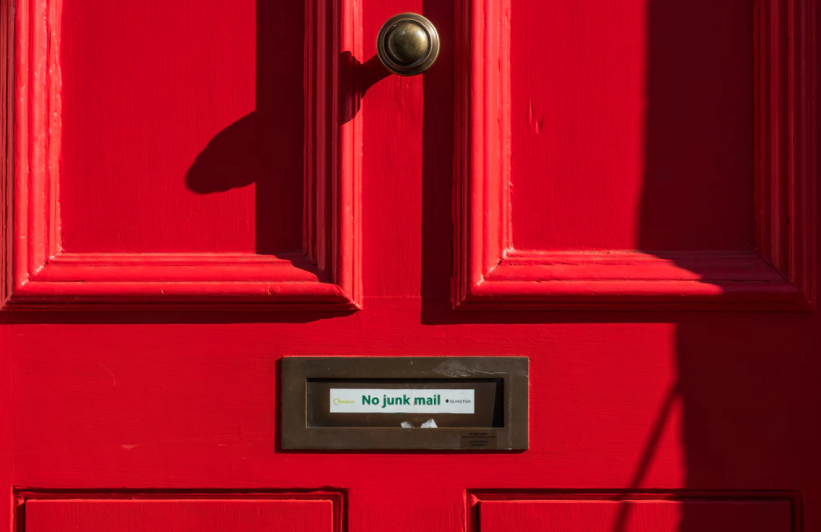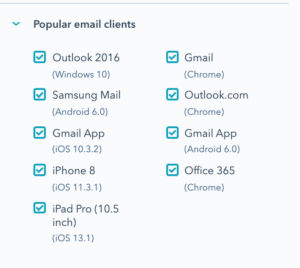
5 Email Marketing Practices to Ditch
Email marketing can be either your business’s BFF or a thorn in your side.
We’ve already preached the good news that email is still reigning queen when it comes to marketing. And contrary to Prince Harry and Meghan Markle leaving the royal family, email marketing isn’t going anywhere.
For more than a decade, 9 Clouds has been working with businesses to craft an intuitive email marketing strategy that engages and delights your audience.
Throughout the last 10 years, we’ve also seen some pretty horrendous email designs and sending practices. We (and your entire CRM database) need them to stop!
Here are the top email marketing practices to give up for good.
5 Email Marketing Practices to Give Up
1. Not Sending Marketing Emails at All
The first email marketing practice to stop immediately is . . . well, not sending emails from your business at all.
While you may communicate directly with customers through work emails, your business should also be sending creative promotional emails to qualified contacts in your customer relationship management (CRM) system.
Think everyone just ignores email? Consider this: 74% of professionals name email as their favorite mode of communication.
Now, consider your own email habits. If I had to guess, you definitely engage with at least a few emails from brands or businesses every week. And the emails you do ignore probably shouldn’t have been sent to you in the first place.
One of the best aspects of email marketing is the cost — or, rather, lack of cost. Most email marketing platforms are affordable or even free, so you’re almost guaranteed a positive return on investment (ROI)!
What to Do Instead
If your business has a CRM with accurate contact information, there’s no excuse to not send email!
Not sure where to begin with email? Start with our many available email marketing resources.
2. “Blasting” Your Entire CRM
You’ve heard the phrase “email blast.” Heck, maybe you even mentioned it in your last marketing meeting.
Email blasting is the practice of sending a single email to a majority or all of the contacts in your CRM, regardless of where they may be in the buyer’s journey.
Why is this bad? Consider these three contacts in an auto dealer’s CRM:
- Jack: Purchased a new F-150 truck three months ago
- Sam: Submitted a test drive form on your website for an F-150
- Staci: Owns a 2012 F-150 and has not purchased a truck since
Now, let’s say the dealership’s marketing manager wants to send an email promoting this month’s lease offers on a new F-150. Should Jack, Sam, and Staci all receive this email? Probably not.
What to Do Instead
Sam should definitely receive this email, as he has indicated he’s interested in an F-150 by completing the test drive form on your website.
Staci would also be a good contact to include in this email, as she has owned her 2012 F-150 for eight years and may be looking to upgrade soon.
Jack shouldn’t receive this email of F-150 lease offers, as he just purchased three months ago and most likely won’t be ready to purchase again for at least a couple more years. Jack is better suited to be sent emails promoting service or dealership event emails.
Bigger is not always better when it comes to email send lists for car dealers.
Typically, the smaller the list, the more qualified those contacts are to take the action you want!
3. Skipping the A/B Test
So you’ve built your beautiful email and have your perfect list. You’re ready to click “send,” but are you forgetting something?
Based on our experience, very few are taking the time to A/B test their emails. Also referred to as split testing, A/B testing is comparing two versions of an email with one single variable in order to see which one performs better.
Need some A/B test inspiration? Here are a few of our favorite email variables to test:
- Subject line
- Sender name
- Call-to-action (CTA) button
- Image banner of offers vs. bulleted offer list
- Send time
It’s easy to get into a habit of sending the same type of email at the same time of day you always send emails. But is this strategy actually working for you? Have you tested it out against other variables?
A/B testing can provide you with valuable insight to your audience.
Do certain customers open emails more in the afternoon? Does having your CTA button close to the top of the email help people click on it more?
You can find out this information and more by just testing two versions of one email.
What to Do Instead
While your test results won’t always be conclusive, consistently incorporating A/B testing into your email marketing will help you refine your strategy to see which methods work best for your dealership.
A/B testing every single email is a bit much, and you’re bound to get burned out.
Begin by testing emails that are scheduled to send to your larger lists. These tests will produce more reliable results and give you better insight into how your customers engage with your emails.
4. Not Making Your Email Mobile Friendly
Yes, we understand you are likely building and designing your emails on a desktop computer, but a large chunk of your audience will be viewing those emails on their mobile devices.
According to our research, 85% of people use a smartphone to regularly check their emails, and that number is expected to increase with time.
Unfortunately, what may look awesome on a desktop may not look as great on mobile. Plus, images and columns can easily become distorted when they aren’t formatted correctly. Subject lines and preview text may also be shortened on mobile.
Don’t think a stretched-out image or off-centered CTA button will affect your email performance? If an email displays poorly on mobile, no matter how good the content is, 50% of people will delete it.
What to Do Instead
Most email marketing platforms will give you the option to preview the email on mobile devices before you send, like HubSpot does:
We also recommend sending a test version to yourself to see how the email renders on your own mobile device.
5. Assuming All of Your Contacts Want to Receive Email
Good digital marketing relies on good data, especially when it comes to your email lists.
While most people who provide their email addresses to your business are okay with receiving email communication, you should not assume this is the case for everyone.
In light of Europe’s GDPR and California’s CCPA, data privacy regulations will continue to be a priority for marketers and any business sending emails.
If too many people mark your emails as spam, you could be at risk of being unable to send emails in the future.
What to Do Instead
To prevent your email marketing from deliverability setbacks, it’s important to make sure your CRM data is clean.
Talk to your team about accurate data entry, and regularly cleanse your CRM of email addresses that have bounced or unsubscribed.
You can also choose to adopt a double opt-in strategy for your dealership’s email marketing. It’s called a “double” opt-in process because, along with providing you their email address through form submission or simply giving it to a salesperson, a contact will also need to take a second step: clicking on a confirmation email.
There are many pros and cons to the double opt-in method, and we break them down here.
Get More Email Marketing Tips
Ditching outdated email best practices isn’t the only way to improve your email marketing.
Learn how to craft a personal and effective email marketing strategy that aligns with your business goals when you check out our free resources.
And when you’re ready to work with an agency that gets email marketing, take a look at how we partner with you to create emails that deliver results.
Win the Inbox With Email Marketing »





